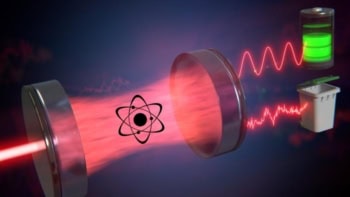By James Dacey

In the May issue of Physics World, science writer Jon Cartwright explores some of the most profound questions about the nature of reality. His feature, “The life of psi”, engages with an apparently simple question: what are quantum wavefunctions? Of course, like many of the most interesting questions in physics, the answer to the question is far from elementary. In fact, it is a question that goes right to the heart of quantum mechanics and philosophy, and one that has puzzled some of the greatest minds for the best part of a century.
As students learn in undergraduate physics courses, Schrödinger’s equation describes how the state of an atom – or any system for that matter – evolves in time. Since Schrödinger published his equation in 1926, it has proved incredibly useful for calculating that properties of particles, such as their positions and energies. But despite its familiarity to physicists, the equation’s solution, known as the wavefunction denoted by the Greek letter psi, has always remained something of a mystery. Is it actually a wave? Is it just a mathematical quirk? What does it really tell us about reality?
Cartwright’s feature identifies the four main interpretations of the wavefunction, which have emerged since Schrödinger unleashed it on the theoretical-physics community. The article can be seen by members of the Institute of Physics in the May print and digital editions of Physics World. You can also view the article here.
In this week’s Facebook poll, we would like you to share your interpretation of this fundamental question.
What are quantum wavefunctions?
They describe the quantum world, they accord with observations (Bohr view)
They are probabilistic knowledge about a deeper reality (Einstein view)
They are “pilot waves” that guide particles (Bohm view)
They are reality on their own (Everett view)
Let us know by visiting our Facebook page. And please feel free to explain your response by posting a comment either on the Facebook page or below this blog article.
In last week’s poll we asked you to provide us with some feedback in relation to the videos we produce. We asked you to select from a list the type of video you like to see more of on physicsworld.com. The overwhelming favourite, with 78% of votes, was “explainer videos”. By this, we mean short videos providing a description or explanation of key concepts and questions from a given field.
You will be glad to know that your wish, as it were, is our command. Over the next few weeks we will be releasing a batch of new videos as part of our 100 Second Science collection. In this video series, experts answer some of the biggest and quirkiest questions in physics within a timeframe of – yes, you guessed it – 100 seconds. Here is an example in which Daniel Mortlock of Imperial College London addresses the same topic as this blog post.
[brightcove videoID=phw.live/2013-03-06-shorts-quantum-wavefunction/1 playerID=106573614001 height=268 width=390]



